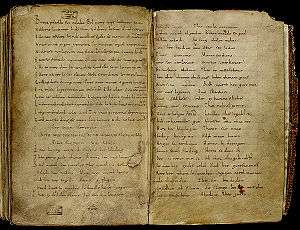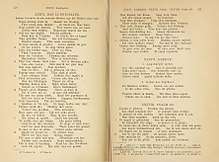Ludwigslied

The Ludwigslied (in English, Lay or Song of Ludwig) is an Old High German (OHG) poem of 59 rhyming couplets, celebrating the victory of the Frankish army, led by Louis III of France, over Danish (Viking) raiders at the Battle of Saucourt-en-Vimeu on 3 August 881.
The poem is thoroughly Christian in ethos. It presents the Viking raids as a punishment from God: He caused the Northmen to come across the sea to remind the Frankish people of their sins, and inspired Louis to ride to the aid of his people. Louis praises God both before and after the battle.
Although the poem is Christian in content, and the use of rhyme reflects Christian rather than pagan Germanic poetry, it belongs to the genre of Preislied, a song in praise of a warrior, of a type which is presumed to have been common in Germanic oral tradition.
The poem is preserved in over four pages in a single 9th-century manuscript formerly in the monastery of Saint-Amand, now in the Bibliothèque municipale, Valenciennes (Codex 150, f. 141v-143r). In the same manuscript, and written by the same scribe, is the Old French Sequence of Saint Eulalia.

The poem speaks of Louis in the present tense: it opens, "I know a king called Ludwig who willingly serves God. I know he will reward him for it". Since Louis died in August the next year, the poem must have been written within a year of the battle. However, in the manuscript, the poem is headed by the Latin rubric Ritmus teutonicus de piae memoriae Hluduice rege ("German song to the beloved memory of King Louis"), which means it must be a copy of an earlier text.
Most regard it as the sole textual example of the otherwise little known West Frankish dialect, which is assumed to have been the language of the Salian Franks.[1][2] This dialect is supposed to have been a descendant of Old Frankish that was spoken in West Francia, closely related to the Franconian dialects of Old High German as spoken in East Francia, but not identical with any single one of them. (It may also be attested in a small OHG–Latin glossary known as Pariser Gespräche; it does not only give translations for single words but also for short everyday sentences, acting as a sort of practical language guide or phrase book for travellers.) Some regard it as Rhenish Franconian, though there are some peculiarities which have received a variety of explanations.[3][4] It is assumed that the manuscript was written by a bilingual scribe in Saint-Amand and we have no other example of an OHG text from this area.
Notes
- ↑ Robinson, Orrin W. (2003-09-02). Old English and Its Closest Relatives: A Survey of the Earliest Germanic Languages. Routledge. p. 196. ISBN 9781134849000.
- ↑ Sanders, Ruth (2010-06-21). German: Biography of a Language. Oxford University Press. p. 110. ISBN 9780199889167.
- ↑ Fought 1979, p. 845: "editors and other scholars generally agree in attributing [the Ludwigslied] to Rhine Franconian, but with some uncertainties or reservations in each case".
- ↑ Harvey 1945, p. 12: "that the main dialect of the poem is Rhenish Franconian has never been called into question".
Further reading
- Althochdeutsches Lesebuch, ed. W. Braune, K. Helm, E. A. Ebbinghaus, 17th ed., Tübingen 1994. ISBN 3-484-10707-3. Includes the standard edition of the text.
- Bostock, J. Knight; King, K. C.; McLintock, D. R. (1976). A Handbook on Old High German Literature (2nd ed.). Oxford. pp. 235–248. ISBN 0-19-815392-9. Includes a translation into English. Limited preview at Google Books
- Fouracre, Paul (1985). "The Context of the Old High German Ludwigslied". Medium Aevum. 54 (q): 87–103. doi:10.2307/43628867.
- Fought, John (1979). "The 'Medieval Sibilants' of the Eulalia–Ludwigslied Manuscript and Their Development in Early Old French". Language. 55 (4): 842–58. doi:10.2307/412747.
- Green, Dennis H., 'The "Ludwigslied" and the Battle of Saucourt', in Judith Jesch (ed.), The Scandinavians from the Vendel period to the tenth century, Boydell Press, 2002, pp. 281–302. Limited preview at Google Books
- Harvey, Ruth (1945). "The Provenance of the Old High German Ludwigslied". Medium Aevum. 14: 1–20. doi:10.2307/43626303.
- McKitterick, Rosamond (2008). The Carolingians and the Written Word. Cambridge: Cambridge University Press. pp. 232–235. ISBN 978-0521315654.
- Rossi, Albert Louis (1986). Vernacular Authority in the Late Ninth Century: Bilingual Juxtaposition in MS 150, Valenciennes (Eulalia, Ludwigslied, Gallo-Romance, Old High German) (PhD thesis). Princeton University.
- Schwarz, Werner (1947). "The "Ludwigslied", a Ninth-Century Poem". Modern Language Review. 42 (2): 467–473. doi:10.2307/3716800.
- Wolf, Alois. "Medieval Heroic Traditions and Their Transitions from Orality to Literacy". In Vox Intexta: Orality and Textuality in the Middle Ages, ed. A. N. Doane and C. B. Pasternack, 67–88. Madison: University of Wisconsin Press, 1991. Limited preview at Google Books
- Yeandle, David N (1989). "The Ludwigslied: King, Church and Context". In Flood, John L; Yeandle, David N. "'Mit regulu bithuungan'": Neue Arbeiten zur althochdeutschen Poesie und Sprache. Göppingen: Kümmerle. pp. 18–79. ISBN 3-87452-737-9.
External links
- Le Rithmus teutonicus ou Ludwigslied - facsimile and bibliography from the Bibliothèque Municipale, Valenciennes (in French)
- High quality facsimile of all four sheets (Bibliotheca Augustana)
- Transcription of the text (Bibliotheca Augustana)
- OHG text from Wright's Old High German Primer (1888)
- OHG text and modern German translation
- OHG text with modern French translation